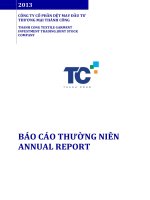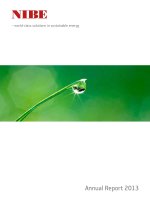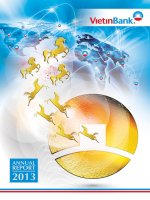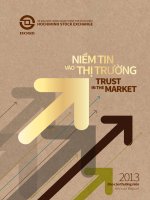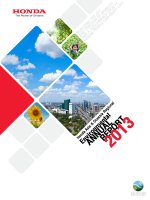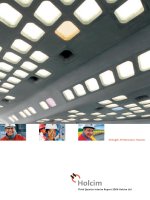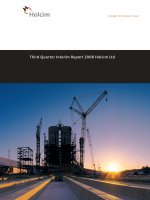On the move annual report 2013 holcim ltd
Bạn đang xem bản rút gọn của tài liệu. Xem và tải ngay bản đầy đủ của tài liệu tại đây (24.19 MB, 266 trang )
Strength. Performance. Passion.
On the move
Annual Report 2013
Strength. Performance. Passion.
Annual Report 2013 Holcim Ltd
Holcim is one of the world’s leading building materials
companies and has a presence on all continents. With
its innovative products and services and a commitment
to sustainable construction, Holcim is contributing to the
success of its customers around the world – as a trusted
partner for more than 100 years. In 2013, the Group’s global
workforce of around 70,000 employees continued to work
hard in order to further strengthen Holcim’s position
as a market leader in cement, aggregates, and ready-mix
concrete. This Annual Report describes specific exemplary
projects that were initiated as part of the Holcim Leader-
ship Journey, which was launched in 2012 and is key to
the future success of the Group. These initiatives and the
motivated employees behind them each contribute toward
reaching the target of increasing operating profit by at least
CHF 1.5 billion by the end of 2014 – under similar market
conditions and with the 2011 financial year as a base line.
This journey around the Holcim world with stories of
different topics provides an in-depth view into the variety
of measures that make up the Holcim Leadership Journey.
Key figures Group Holcim
2013 2012
1
±% ±%
like-for-
like
Annual cement production capacity million t 206.2 209.3
–1.4 –0.3
Sales of cement million t 138.9 142.3
–2.4 –1.2
Sales of mineral components million t 4.1 4.8
–14.8 –3.8
Sales of aggregates million t 154.5 158.2
–2.4 –0.8
Sales of ready-mix concrete million m
3
39.5 45.3
–12.9 –7.4
Sales of asphalt million t 8.9 9.1
–2.0 –0.1
Net sales million CHF 19,719 21,160
–6.8 +0.2
Operating EBITDA million CHF 3,896 3,889
+0.2 +7.0
Operating EBITDA adjusted
2
million CHF 3,896 4,128
–5.6 +0.8
Operating EBITDA margin % 19.8 18.4
Operating EBITDA margin adjusted
2
% 19.8 19.5
Operating profit million CHF 2,357 1,749
+34.8 +43.7
Operating profit adjusted
2
million CHF 2,357 2,485
–5.1 +1.1
Operating profit margin % 12.0 8.3
Operating profit margin adjusted
2
% 12.0 11.7
EBITDA million CHF 4,332 4,352
–0.5
Net income million CHF 1,596 1,002
+59.3
Net income margin % 8.1 4.7
Net income – shareholders of Holcim Ltd million CHF 1,272 610
+108.4
Cash flow from operating activities million CHF 2,787 2,643
+5.4 +12.5
Cash flow margin % 14.1 12.5
Net financial debt million CHF 9,461 10,325
–8.4 –4.0
Funds from operations
3
/net financial debt % 33.4 30.5
Total shareholders' equity million CHF 18,677 19,234
–2.9
Personnel 70,857 76,359
–7.2 –5.4
Earnings per share CHF 3.91 1.89
+106.9
Fully diluted earnings per share CHF 3.91 1.89
+106.9
Payout million CHF
425
4
374
+13.6
Payout per share CHF
1.30
4
1.15
+13.0
1
Restated due to
changes in
accounting policies.
2
E x c l u d i n g
restructuring costs
in 2012.
3
Net income plus
depreciation,
amortization and
impairment.
4
Proposed by the
Board of Directors
for a maximum
payout of CHF 425
million from capital
contribution
reserves.
Due to rounding,
numbers presented
throughout this
report may not add
up precisely to the
totals provided.
All ratios and
variances are
calculated using
the under-
lying amount
rather than the pre-
sented rounded
amount.
Principal key figures in USD (illustrative)
2013 2012
1
±%
Net sales million USD 21,276 22,602
–5.9
Operating EBITDA million USD 4,203 4,154
+1.2
Operating EBITDA adjusted
2
million USD 4,203 4,409
–4.7
Operating profit million USD 2,543 1,868
+36.1
Operating profit adjusted
2
million USD 2,543 2,654
–4.2
Net income – shareholders of Holcim Ltd million USD 1,373 652
+110.5
Cash flow from operating activities million USD 3,007 2,823
+6.5
Net financial debt million USD 10,634 11,284
–5.8
Total shareholders' equity million USD 20,992 21,021
–0.1
Earnings per share USD 4.22 2.02
+109.0
Principal key figures in EUR (illustrative)
Net sales million EUR 16,022 17,548
–8.7
Operating EBITDA million EUR 3,165 3,225
–1.9
Operating EBITDA adjusted
2
million EUR 3,165 3,423
–7.5
Operating profit million EUR 1,915 1,450
+32.1
Operating profit adjusted
2
million EUR 1,915 2,061
–7.1
Net income – shareholders of Holcim Ltd million EUR 1,034 506
+104.1
Cash flow from operating activities million EUR 2,264 2,192
+3.3
Net financial debt million EUR 7,717 8,552
–9.8
Total shareholders' equity million EUR 15,235 15,930
–4.4
Earnings per share EUR 3.18 1.57
+102.7
Holcim Ltd
Corporate Communications
Markus Jaggi
Phone +41 58 858 87 10
Fax +41 58 858 87 19
Holcim Ltd
Investor Relations
Bernhard A. Fuchs
Phone +41 58 858 87 87
Fax +41 58 858 80 09
Annual Review 2013 8
Shareholders’ Letter 12
Interview with the Executive Committee 16
Value-Driven Corporate Management 22
Key Success Factors 22
Holcim Leadership Journey 28
Organization and Management 44
Innovation 52
Capital Market Information 64
Sustainable Development 69
Environmental Commitment and Social Responsibility 69
Human Resources 75
Business Review 86
Group Region Asia Pacific 86
Group Region Latin America 90
Group Region Europe 94
Group Region North America 98
Group Region Africa Middle East 102
Corporate Governance 113
Remuneration Report 134
Financial Information 145
MD & A 145
Consolidated Financial Statements 161
Key Management Compensation 237
Company Data 248
Holding Company Results 254
5-Year-Review 263
Articles about the special topic Holcim Leadership Journey can be found on the following pages:
page 34: OH&S and Customer Excellence ; page 56: Procurement and Logistics;
page 78: Energy and AFR; page 104: Fixed Costs and Investments Costs
Contents
8
Consolidated key figures for North America
Net sales in million CHF 3,171
Net sales in % of Group turnover 15.6
Operating EBITDA in million CHF 494
Cement and grinding plants 17
Aggregates plants 116
Ready-mix concrete and asphalt plants 263
Personnel 6,791
Consolidated key figures for Latin America
Net sales in million CHF 3,349
Net sales in % of Group turnover 16.5
Operating EBITDA in million CHF 938
Cement and grinding plants 27
Aggregates plants 18
Ready-mix concrete plants 119
Personnel 11,181
Higher operating EBITDA margin and net income
Annual Review 2013
9
Consolidated key figures for Asia Pacific
Net sales in million CHF 7,282
Net sales in % of Group turnover 35.9
Operating EBITDA in million CHF 1,473
Cement and grinding plants 51
Aggregates plants 84
Ready-mix concrete plants 320
Personnel 34,080
Consolidated key figures for Africa Middle East
Net sales in million CHF 884
Net sales in % of Group turnover 4.4
Operating EBITDA in million CHF 283
Cement and grinding plants 12
Aggregates plants 5
Ready-mix concrete plants 17
Personnel 2,128
Consolidated key figures for Europe
Net sales in million CHF 5,611
Net sales in % of Group turnover 27.6
Operating EBITDA in million CHF 946
Cement and grinding plants 35
Aggregates plants 203
Ready-mix concrete and asphalt plants 463
Personnel 15,868
10
Cement
Profile
Cement is manufactured through a large-scale,
complex, and capital and energy-intensive process.
At the core of the production process is a rotary kiln, in
which limestone and clay are heated to approximately
1,450 degrees Celsius. The semifinished product, called
clinker, is created by sintering. In the cement mill,
gypsum is added to the clinker and the mixture is
ground to a fine powder – traditional Portland cement.
Other high-grade materials such as granulated blast
furnace slag, fly ash, pozzolan, and limestone are
added in order to modify the properties of the cement.
Holcim offers customers a very wide range of cements.
However, the Group sees itself as a service provider
that generates added value for its partners through
the advice it gives and the customized solutions it
delivers for specific construction projects.
Developments
Cement volumes in 2013 reached 138.9 million tonnes,
a drop of 2.4 percent. The Group also sold 4.1 million
tonnes of mineral components. The development was
particularly impacted by lower volumes in Asia Pacific.
In addition Group regions North America and Africa
Middle East also recorded lower volumes. In Europe
cement volumes were on the up, mainly due to ongo-
ing high demand levels in Russia and Azerbaijan. Latin
America recorded volumes that were on par with the
previous year.
Profile
Aggregates include crushed stone, gravel, and sand.
The production process centers around quarrying,
preparing and sorting the raw material as well as
quality testing. Aggregates are mainly used in the
manufacturing of ready-mix concrete, concrete prod-
ucts, and asphalt, as well as for road building and
railway track beds. The recycling of aggregates from
concrete material is gaining importance at Holcim.
Developments
In 2013, aggregate sales volumes were down 2.4 per-
cent to 154.5 million tonnes. Demand for crushed stone,
gravel, and sand was higher in North America, due to
positive market development in the US, and in Europe
it was on a par with 2012. In Asia Pacific, volumes
were down as Australia recorded lower sales. In Latin
America restructuring of aggregate operations led to
a more pronounced decrease in volumes.
Aggregates
Profile
Globally, concrete is the second most consumed
commodity by volume after water. One cubic meter
consists of approximately 300 kilograms of cement,
150 liters of water, and 2 tonnes of aggregates.
Concrete is a very environmentally friendly, energy-
efficient building material. Asphalt is a bituminous
construction material used primarily for road paving.
It consists mainly of aggregates of differing grain
size. Holcim’s service offering also includes construc-
tion services and international trading.
Developments
Ready-mix concrete deliveries decreased by 12.9 percent
to 39.5 million cubic meters in 2013 as many Group
companies restructured operations in this segment to
improve their profitability. All Group regions reported
lower volumes in this segment. Asphalt sales were
affected by lower demand from Canada and the United
States, while in the United Kingdom sales were higher
in 2013. Group-wide volumes were down 2 percent and
reached 8.9 million tonnes.
Other construction materials and services
Annual Review 2013
11
Sales of cement
Million t
160
140
120
100
80
60
40
20
0
2010 2012 201320112009
Sales of aggregates
Million t
200
180
160
140
120
100
80
60
40
20
0
Sales of ready-mix concrete
Million m
3
50
40
30
20
10
0
2010 2012 201320112009
2010 2012 201320112009
Consolidated key figures for cement in 2013
Production capacity cement in million t 206.2
Cement and grinding plants 142
Sales of cement in million t 138.9
Net sales
1
in million CHF 12,939
Operating EBITDA
1
in million CHF 3,252
Personnel 47,179
1
Includes all other cementitious materials
Consolidated sales of cement 2013 per region
1
Asia Pacific 70.3 million t
Latin America 25.0 million t
Europe 26.7 million t
North America 11.7 million t
Africa Middle East 7.9 million t
1
Inter-regional sales -2.6 million t
Consolidated key figures for aggregates in 2013
Aggregates plants 426
Sales of aggregates in million t 154.5
Net sales in million CHF 2,428
Operating EBITDA in million CHF 448
Personnel 5,812
Consolidated sales of aggregates 2013 per region
Asia Pacific 25.2 million t
Latin America 10.2 million t
Europe 74.1 million t
North America 42.8 million t
Africa Middle East 2.2 million t
Consolidated key figures
for other construction materials and services in 2013
Ready-mix concrete plants 1,091
Asphalt plants 91
Sales of ready-mix concrete in million m
3
39.5
Sales of asphalt in million t 8.9
Net sales in million CHF 6,812
Operating EBITDA in million CHF 195
Personnel 17,376
12
Dear shareholder,
The global economy grew only slightly over the course of 2013. Although moderate growth was recorded in North
America, the Eurozone continued to be burdened by the need to remedy the excessive levels of debt. However,
the recession came to an end in the summer, even if the economic recovery was still very tentative.
The production growth rates recorded in emerging markets suffered larger declines than those in many of the
advanced economies. In addition to a lack of demand from the advanced economies, the slowing down of the un-
derlying growth rate due to domestic problems had a noticeable impact. Some countries temporarily experienced
considerable capital outflows in the middle of the year, as many investors sought to minimize the amount of risk
to which their investments would be exposed in light of the change in monetary policy announced in the United
States. The announcement that the US would be implementing a stricter monetary policy caused a number of
Asian currencies – most notably in Indonesia and India - to tumble; in some cases, significantly.
In view of these events, the volume development at Holcim was negative in all three segments, and net sales suf-
fered a 6.8 percent decline to CHF 19.72 billion. It was significantly harder to implement price increases in various
markets than it was in the previous year. Operating EBITDA was negatively impacted by the Group companies
in India, Mexico, Canada, and Brazil in particular. Nevertheless, Holcim recorded stable operating EBITDA of
CHF 3.9 billion. Net income significantly increased by 59.3 percent to CHF 1.6 billion, reflecting our culture of cost
control in production, logistics, and administration.
Holcim generated a solid result in the 2013 financial year.
Despite difficult market conditions, as a result of which
volumes in all three segments were below those recorded
last year, the operating EBITDA margin and net income
increased due to the consistent implementation of the
Holcim Leadership Journey.
13
Shareholders’ Letter
Holcim Leadership Journey on track
The Holcim Leadership Journey made a significant contribution to the positive result and achieved the objectives
set for 2013. The various workstreams of the Holcim Leadership Journey, which particularly gathered pace from
the middle of the year, generated a contribution of CHF 943 million to the operating profit recorded in the finan-
cial year. ROIC before taxes increased from 6.8 percent in 2012 to 9.1 percent.
Holcim continues to maintain a strong balance sheet and a good balance between equity and debt, so the
Group’s net debt fell by CHF 864 million to CHF 9.46 billion.
The Holcim Leadership Journey is of particular importance across the entire Group. We have therefore reserved
a special section for it in this Annual Report. We will provide specific projects as examples, in order to show you
how our employees are undertaking this demanding journey.
Aim to further optimize value creation
Thanks to Holcim’s existing global footprint, the Group can moderate its expansion capex to lower levels. We are
currently concentrating on generating optimum added value from the investments made in previous years. We
still continue to invest as shown by the existing pipeline of projects, for example in Brazil, India, and Indonesia.
Geographic realignment in Europe
In order to accommodate the evolving economic conditions and remain well positioned in the future, Holcim is
further optimizing its presence in Europe. We plan to purchase certain positions in western Germany, a cement
factory, two cement mills, a granulated slag production facility, and as well as several locations for aggregates
and ready-mix concrete plants, and combine these with our existing business in northern Germany. Part of the
transaction also includes selling Holcim Cesko. In Spain, we intend to combine all activities involving cement,
ready-mix concrete and aggregates with Cemex. Holcim will hold a 25 percent stake in the combined unit. These
transactions will help us to significantly increase our presence in Germany, while at the same time providing
us with the necessary level of flexibility in Spain. We are confident of receiving the approvals required from the
respective authorities.
In addition, Group management has been further streamlined and responsibilities within the individual regions
redefined. We are pressing ahead with the development of a new generation of managers, who have a widely
diversified commercial and technical background and as well as a solid track record in the area of occupational
health and safety.
14
Commitment towards sustainability
Holcim’s strategy has been characterized by sustainability for quite some time. This is how we intend to
reconcile long-term profitability with ecological and social progress. Long-term corporate values can only be
created through sustainable business practices. Our efforts and successes in this area, which we have detailed
in a separate environmental and social report, have once again resulted in Holcim being listed on the Dow
Jones Sustainability Index. This means that Holcim has been on both the Dow Jones Sustainability World Index
and the Dow Jones STOXX Sustainability Index for 11 years now and is among the leading companies in
the sector in this field.
Payout to shareholders
We are adhering to our principle that one-third of net income attributable to shareholders of Holcim Ltd should
be distributed to shareholders. At the Annual General Meeting at the end of April 2014, we will propose increas-
ing the payout per each registered share by 13 percent to CHF 1.30.
Outlook 2014
For 2014, Holcim expects the global economies to show another year of uneven performance. Construction
markets in Europe are expected to have reached the bottom, with a slow recovery in sight. At the same time,
North American markets are expected to continue to benefit from a further recovery, especially in the United
States. Latin America, on the other hand, could continue to face uncertainties in Mexico but should overall
show slight growth in 2014. The Asia Pacific region is expected to grow, although at a comparatively slower
pace than experienced in recent years. Africa Middle East is expected to gradually improve.
Holcim expects cement volumes to increase in all Group regions in 2014. Aggregates volumes are expected to
remain flat overall, as increases in Asia Pacific, Europe, North America, and Africa Middle East are offset
by negative volumes in Latin America. In ready-mix concrete, volumes are also expected to increase in most
regions, with the exception of Europe and Latin America.
The Board of Directors and Executive Committee expect that organic growth in operating profit can be achieved
in 2014. The ongoing focus on the cost base coupled with all the benefits expected from the Holcim Leadership
Journey will lead to a further expansion in operating margins in 2014.
A word of thanks to shareholders, customers, partners and employees
There is a great deal of spirit and energy within Holcim. The expertise and commitment shown by our employees
have helped to make the company what it is today – an industry leader. The dedication that our employees have
exhibited in their daily tasks to meet the various challenges faced has demonstrated that our teams around
the world remain our most important asset. We would therefore like to thank them. We would like to take this
opportunity to also pay tribute to their generosity, expressed through the many volunteering projects under-
taken or in their generous donations to those affected by Typhoon Haiyan in the Philippines. For the latter,
Holcim doubled the total raised.
15
Shareholders’ Letter
We would also like to say a big thank you to our customers, business partners, and suppliers, and look forward to
continuing our good working relationship in 2014.
We would especially like to thank you, our shareholders, for the loyalty and confidence that you have shown us
over the past year. We hope that you continue to place your trust in us. Our focus is on developing solutions
that make our customers more successful, and we are committed to operating and developing our positions and
assets in a way that provides our shareholders with attractive returns.
Rolf Soiron Bernard Fontana
Chairman of the Board of Directors Chief Executive Officer
Zurich, February 2014
1716
Why should one invest in the building materials
sector and why in Holcim in particular?
Bernard Fontana: Overall, we are in a favorable
position with promising growth prospects for the
industry—and with strong teams to deliver world-
wide. Holcim with its strong footprint, in emerg-
ing and mature markets, is well placed to reap the
benefits from three megatrends—population growth,
economic growth, as well as urbanization. These will
continue to drive demand for cement, aggregates,
and concrete over the coming years.
Thomas Aebischer: We have one of the most solid
balance sheets in the industry and consequently
continue to receive investment grade ratings. There
are two additional factors that make Holcim a very
attractive stock—our risk profile and our commitment
to sustainable development. Firstly, as our presence is
spread across five continents, including mature and
emerging markets, we are in a good position to deal
The economic success, credibility, and reputation of a company are all influenced
by the actions of corporate management. On the one hand, for this the expertise
of each individual plays an important role, whilst on the other it is only through
the cooperation of all members of the Executive Committee that a strategy can
be effectively implemented and coordinated across the Group. Over the following
pages, the CEO and the Executive Committee explain why Holcim is a profitable
investment, how the strategy looks in terms of geographical orientation and the
development of individual segments, how global standards are being met, and
how the Holcim Leadership Journey will be implemented going forwards.
“True leadership
builds on passion”
with the two-speed economy and thus our risk profile
is balanced. Secondly, with our global focus on sustain-
able development we not only strengthen our competi-
tive position in the markets but also show our strong
commitment to the society we operate in. Sustainable
development can earn our licence to operate. This of-
fers Holcim a very attractive risk-reward relation.
Holcim has restructured its aggregates and ready-
mix business in a number of countries and has also
closed sites. What are the perspectives for these
two segments?
Roland Köhler: Aggregates and ready-mix concrete
remain important business segments for us; how-
ever, we run them based on the value they add—
either as stand-alone businesses or in combination
with other offerings that we have in a market. So
the aim is not to build up—or maintain—positions
in all three segments in all of the countries in which
we are present, but to focus on the markets and
circumstances where it makes business sense to have
an aggregates or ready-mix concrete presence. If we
want to provide tailor-made solutions to our custom-
ers, an integrated business would especially add a lot
of value.
In many markets, you are faced with competition
from local companies that have a geographically-
limited presence. What are the overall advantages
of a global building materials provider?
Andreas Leu: Latin America provides us with a good
example of how we can leverage our size, which of
course is a major benefit of being a global provider.
In order to allow our local companies to focus on
operational efforts, we are creating a regional shared
services center in Colombia that bundles administra-
tive services. We can thus reduce back-office costs by
around one-fifth—an achievement clearly not pos-
sible for a local competitor.
Roland Köhler, Thomas Aebischer, Bernard Fontana, Andreas Leu, Bernard Terver
Interview with the Executive Committee
1918
Ian Thackwray, Bernard Terver, Thomas AebischerBernard Fontana, Roland Köhler
Thomas Aebischer: We have numerous global initia-
tives intended to reap large-scale benefits. Our LEAP!
Program, which creates one global procurement team
and aims for cost leadership in procurement, lever-
ages the size of our Group to secure better conditions
with our suppliers. We also work on increasing the
value we can get out of the vast amount of knowl-
edge that exists within Holcim. We encourage and
facilitate sharing and multiplication through various
means – regional and global conferences, technical
centers, or site visits. We are currently also rolling out
a new global collaboration platform based on Google
Apps that offers all employees a state-of-the-art
platform to learn from each other without having
to catch a plane.
A number of cement manufacturers have sold assets
over the last couple of years. Is that a sign that the
industry is about to become more fragmented—
reversing the consolidation trends of the last decade?
Bernard Fontana: We believe that consolidation
will continue. The experience of the last few years
and the current economic environment has led to a
more cautious approach toward acquisitions across
the industry. However, for Holcim, value-creation
for all stakeholders is key. If there are opportunities
that meet our criteria of value creation, strategic fit,
and long-term financing which secures our current
credit rating, we may certainly also be part of future
transactions. We look at this in the context of the
Holcim Leadership Journey and our continued focus
on financial stability.
Overall, the Holcim Leadership Journey is on track.
However, for Customer Excellence, you have not met
your targets. What are the reasons for this?
Ian Thackwray: Our vision of Customer Excellence
is to be the most customer-focused company with
the highest customer loyalty in our industry. We
therefore aim to create more value for our customers
and higher and sustainable returns for the company.
This is a process that takes time and is made even
more challenging by the currently flat or declining
construction activity in some parts of the world.
However, we are confident that we will gain traction
in 2014 and we will continue our in depth work to
implement Customer Excellence in the Group.
If you want to transform the Group, you need com-
mitted employees to do it. What about the people
dimension of the Holcim Leadership Journey?
Paul Hugentobler: Investing in our people has always
been a key element of the Holcim culture – and this
has been accentuated by the Holcim Leadership
Journey. Behavior and culture change do play a key
role here, so leadership development is our focus
at the moment. As we get this right, we can create
an environment in which every employee thrives
and enjoys working. Current employee satisfaction
surveys show that we are already doing many things
right, but we definitely have room for improvement.
Bernard Terver: Our procurement initiative LEAP!
is a great example for personal development. In
the last few months, procurement colleagues from
Bratislava to Manila have undergone a two-step
assessment program, identifying key development
areas. These were then integrated into individual
development plans and specific actions and support
for employees were defined. Ultimately, there
will be a better skilled workforce managing our
ambitious LEAP! Program as a result of this approach.
We are seeing mixed signs from some emerging
markets. In the long-run, do you need to be prepared
for slower growth in these countries? What does this
mean for the importance of mature markets?
Bernard Fontana: In 2013, we indeed faced a slower
growth in some key emerging countries - still, if
we look at the fundamentals, it is pretty clear that
prospects in the emerging countries remain positive.
World population is estimated to reach around 9
billion by 2050 with most of the growth happening
in emerging markets. In addition, urbanization is set
to continue. By 2050, the population living in urban
areas is projected to rise to 6.4 billion – equivalent
to the world’s total population in 2004. We are not
only counting on growth to occur in these countries:
We also have a strong focus on operational excel-
lence there.
Ian Thackwray: Asia is a main driver in this respect.
In 2010, less than half of the population lived in cit-
ies. By 2050, it will be around two-thirds. This situa-
tion naturally requires solutions for the construction
environment – be it for housing or infrastructure.
Roland Köhler: The mature markets of Europe and
North America will continue to play a major role for
us as, for instance, we are now beginning to see signs
of stabilization in the housing market in Europe. In
addition, ageing infrastructure needs to be fixed or
replaced. The figures speak for themselves—the
Interview with the Executive Committee
Bernard Fontana, Andreas Leu, Paul Hugentobler
The members of the Holcim Executive Committee*:
Bernard Fontana, Chief Executive Officer (CEO),
Thomas Aebischer, Chief Financial Officer (CFO),
Roland Köhler, Europe excl. UK,
Andreas Leu, Latin America,
Paul Hugentobler, South Asia and ASEAN excl. Philippines
(until December 31, 2013),
Bernard Terver, South Asia and Africa Middle East
(until December 31, 2013 responsible for North America and
UK),
Ian Thackwray, East Asia Pacific and Trading
(until December 31, 2013 responsible for East Asia, China,
Philippines, Oceania, International Trade)
*as at January 1, 2014
2120
Bernard Terver, Roland Köhler, Thomas AebischerBernard Fontana
OECD expects that USD 53 trillion will need to be
invested to cover the world’s infrastructure needs by
2030. A fair share of this will be in mature markets.
The regulatory environment becomes more
challenging for a globally active group. How do you
balance your global standards with the need to
comply with all relevant local laws and regulations?
Bernard Fontana: First of all, our standards are of
course at least on the same level as the applicable
local law and regulations, if not stricter. This means
that it isn’t always easy to compete with local
competitors, but it is our conviction that we have a
responsibility to uphold what we as a Group be-
lieve is right. This covers many topics—from OH&S
and competition law to bribery and corruption, and
discrimination, etc. We have put in place the nec-
essary means to ensure that we can live up to our
convictions. In compliance, we have a zero-tolerance
policy for violations. And we enforce it. We provide
our employees with anti-bribery and corruption,
and competition law training sessions, both in the
classroom and through e-learning. And these training
sessions are mandatory.
Andreas Leu: The same is true for OH&S. It is our
top priority and we are continuously improving the
awareness and knowledge of our people on how
to protect themselves and others from harm while
working for us. There is nothing so urgent that
it cannot be done safely! Our goal here is Zero Harm
to People and this is not only a headquarters vision.
People are measured on the ground against this goal,
and OH&S track record is an important factor when
we decide on promotions.
What about China? Are you planning to increase
your presence there?
Ian Thackwray: Since 1999, Huaxin Cement has been
our strategic partner in China and we intend to con-
tinue strengthening this partnership in the future. In
addition to consolidating its position in the industry
in China, Huaxin is in the process of transforming its
business model to focus on environmental services.
This is similar to what we are doing with AFR in many
of Holcim’s plants globally, but larger in scale and
driven by the need to find a sustainable solution to
waste for China’s urbanising population. Huaxin’s
development of their waste business benefits from
our vast experience in this area. In China, we are see-
ing major opportunities in this area, given that the
needs are great and that the development of waste
management systems is still at an early stage.
Ian Thackwray
Holcim is talking a lot about leadership. What does
leadership mean to you?
Bernard Fontana: The essence of leadership in
my view is to take people to places they have never
been—and they have never dreamt of being able
to reach. Hence the Holcim Leadership Journey
in which leaders across the Group are invited to
explore new opportunities here and now, develop
themselves, and generate new leaders with a strong
focus on performance and the sustainability of the
transformations we lead. A message I constantly give
to them is that despite all the challenges, the long
working hours, and the drawbacks they encounter,
they should enjoy this journey. True leadership builds
on conviction and passion and can only thrive in an
environment where leaders are given the necessary
freedom to learn and develop—every day and at
every level of the organization.
Bernard Terver: The management changes that be-
came effective at the beginning of the year are proof
to how much importance we place on leadership
development and succession within Holcim.
For me personally—as someone who has been with
Holcim for more than 30 years—it is very reassuring
to see that we have these talented colleagues who
are willing to take responsibility within our company.
There has been a lot of talk about Holcim’s sustain-
ability credentials in recent years but it seems you
have been a little quiet about your efforts here.
What is the current role of sustainable development
for the Group?
Roland Köhler: Over the last couple of years, Holcim
has indeed developed into an industry leader in
sustainability. It is our intention to build on this
strong position and to renew our commitment to
sustainability. We want to go beyond Holcim’s
operations and include customers or communities
and take a lifecycle approach to buildings and
infrastructure. We also want to go beyond CO2 and
look holistically at our resource management and
the value we create for society.
Interview with the Executive Committee
Value-Driven
Corporate Management
22
Strategy supports program to increase rate of return on
invested capital
Holcim’s strategy is based on three principles of
success: The focus on the Group’s core construction
materials businesses; a targeted, broad-based geo-
graphical diversification, with continuously improving
positions in growth markets; and a balance between
global strategic and local operational leadership.
These principles have proven themselves in different
economic environments allowing for decisive and
rapid responses in changing business conditions.
A good example is the Holcim Leadership Journey,
launched in May 2012 – for details, please see the
following section.
Key success factors
Holcim’s vision is to provide foundations for society’s future.
To do so, the Group supplies customers across the globe with
cement, aggregates, ready-mix concrete, concrete products,
asphalt, and associated services and solutions. From 1,750
production sites located in all major markets of the world,
Holcim supports construction work efficiently, sustainably,
and safely. The Group seeks to grow its business with the
customers and societies it serves. As a consequence, the
asset footprint reflects the growth development of the
construction industry with two-thirds of capacity located
in the rapidly growing emerging markets of Latin America
and Asia.
Building materials as core business
High-quality building materials as a business will
continue to offer interesting opportunities as global
population growth, high-density construction, and
a higher aspiration level continue to generate a stead-
ily increasing demand for better infrastructure and
housing. In many areas, there is a huge backlog of
demand in terms of both quantity and quality.
The basis for Holcim’s success over many decades
has been delivering value-adding products, i.e. ser-
vices and solutions with a clear focus on cement and
aggregates. The Group has for decades attached
great importance to sustainability concepts, as the
23
Key Success Factors
Creation of value
Product focus
Geographic
diversification
Local management
global standards
Goal
Mindsets
Base
People
Strategy
Better cost
manage-
ment
Permanent
marketing
innovation
Human
resources
excellence
Corporate
social
responsi-
bility
Sustainable
environ-
mental per-
formance
Central pillars of value creation
processing of limestone, clay, and marl, and the quar-
rying and processing of crushed stone, gravel, and
sand touch upon natural resources and depend on
significant energy input. In a number of countries,
particularly in mature markets and major urban areas,
Holcim is also active in the ready-mix concrete, con-
crete products, and asphalt businesses. Global expert
teams back up these product offerings with a diverse
range of services, product-specific consulting, and
innovative system solutions specially conceived for
major projects. Tailored concepts for complex build-
ing projects are another success factor in a number of
locations. Holcim runs these business units as profit-
able operations and not only as sales channels for
cement. These operations are regularly monitored in
order to enhance their profit contribution.
Global presence
Holcim operates plants at 1,750 sites in around
70 countries on every continent, including cement
plants, aggregates operations, ready-mix concrete
and concrete elements plants, asphalt facilities, and
platforms for the processing of alternative fuels and
raw materials. The Group’s broad-based presence
demonstrates the value of a balanced portfolio, as it
smoothes out cyclical fluctuations in individual markets
and stabilizes earnings.
Through Holcim Trading, the Group also holds a lead-
ing position in cement, clinker, mineral components,
and solid fuels trading. Holcim Trading also offers a
full range of trading services to members of the Holcim
Group, focusing mainly on supporting the purchase
and sale of such products on international markets.
Balance between global strategic and local operational
leadership
Marketing and selling products, services, and solu-
tions, extracting raw materials, operating cement
plants, and distributing building materials is a local
business. Most customers are operating locally or
regionally. This is why the operational companies are
Creating added
value is Holcim’s
paramount objec-
tive, an objective
that is based on
the three strategic
pillars and deter-
mines guidelines
in the functional
sectors. The most
important founda-
tion on which
everything rests is
a workforce that
gives its best on
a daily basis.
© Holcim Ltd
Value-Driven
Corporate Management
24
Emerging markets
Mature markets
Net sales mature versus emerging markets
100%
90%
80%
70%
60%
50%
40%
30%
20%
10%
0%
52.4% 50.8% 51.2% 51.8%
47.6% 49.2% 48.8% 48.2%
2009 2010 2011 2012
47.5%
2013
52.5%
firmly anchored in their local environment and
why Holcim has always placed a great emphasis on
delegating operational and business responsibilities
to Group companies. However, Group-wide directives,
which make up the Holcim Policy Landscape, must
be applied and complied with globally. This particularly
applies to the Group-wide standards of the profes-
sional behavior expected of all staff. Non-compliance
with the Code of Conduct automatically triggers
disciplinary sanctions.
Occupational health and safety has the highest
priority. As a consequence, the company focuses on
the vision of “zero harm to people”. The Occupational
Health & Safety function reports directly to the Group
CEO. Holcim considers accidents on its sites as unac-
ceptable. Holcim will maintain its target of a Lost
Time Injury Frequency Rate (LTIFR) of less than 1.0 but
in line with best practice also move to a Total Injury
Frequency Rate (TIFR) with a target of below 5.0.
The most important risks, as outlined by the “Fatality
Prevention Elements” are monitored.
In Holcim’s view, alongside occupational health and
safety, the following areas are also of vital importance
for the Group companies and are as such also reflected
in the goals of the Holcim Leadership Journey:
Net Sales per Region 2013 2012
Million CHF
Asia Pacific 7,282
35.9%
8,343
38.2%
Latin America 3,349
16.5%
3,490
16.0%
Europe 5,611
27.6%
5,809
26.6%
North America 3,171
15.6%
3,276
15.0%
Africa Middle East 884
4.4%
947
4.3%
